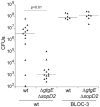A Bacterial Pathogen Targets a Host Rab-Family GTPase Defense Pathway with a GAP
- PMID: 26867180
- PMCID: PMC4854434
- DOI: 10.1016/j.chom.2016.01.004
A Bacterial Pathogen Targets a Host Rab-Family GTPase Defense Pathway with a GAP
Abstract
Cell-autonomous defense mechanisms are potent strategies that protect individual cells against intracellular pathogens. The Rab-family GTPase Rab32 was previously shown to restrict the intracellular human pathogen Salmonella Typhi, but its potential broader role in antimicrobial defense remains unknown. We show that Rab32 represents a general cell-autonomous, antimicrobial defense that is counteracted by two Salmonella effectors. Mice lacking Rab-32 or its nucleotide exchange factor BLOC-3 are permissive to S. Typhi infection and exhibit increased susceptibility to S. Typhimurium. S. Typhimurium counters this defense pathway by delivering two type III secretion effectors, SopD2, a Rab32 GAP, and GtgE, a specific Rab32 protease. An S. Typhimurium mutant strain lacking these two effectors exhibits markedly reduced virulence, which is fully restored in BLOC-3-deficient mice. These results demonstrate that a cell-autonomous, Rab32-dependent host defense pathway plays a central role in the defense against vacuolar pathogens and describe a mechanism evolved by a bacterial pathogen to counter it.
Keywords: Rab GTPases; Rab32; Salmonella Typhi; Salmonella pathogenesis; bacterial pathogenesis; cell-autonomous defense; innate immunity; lysosome-related organelles; lysosomes; macrophages; membrane traffic; type III secretion; typhoid fever.
Copyright © 2016 Elsevier Inc. All rights reserved.
Figures







Similar articles
-
Host restriction in Salmonella: insights from Rab GTPases.Cell Microbiol. 2014 Sep;16(9):1321-8. doi: 10.1111/cmi.12327. Epub 2014 Aug 5. Cell Microbiol. 2014. PMID: 24957519 Review.
-
A novel anti-microbial function for a familiar Rab GTPase.Small GTPases. 2013 Oct-Dec;4(4):252-4. doi: 10.4161/sgtp.27282. Epub 2013 Dec 9. Small GTPases. 2013. PMID: 24321888 Free PMC article.
-
Rab32 restriction of intracellular bacterial pathogens.Small GTPases. 2018 May 4;9(3):216-223. doi: 10.1080/21541248.2016.1219207. Epub 2016 Sep 20. Small GTPases. 2018. PMID: 27645564 Free PMC article. Review.
-
Mechanisms of Salmonella Typhi Host Restriction.Adv Exp Med Biol. 2016;915:283-94. doi: 10.1007/978-3-319-32189-9_17. Adv Exp Med Biol. 2016. PMID: 27193549 Review.
-
Itaconate is an effector of a Rab GTPase cell-autonomous host defense pathway against Salmonella.Science. 2020 Jul 24;369(6502):450-455. doi: 10.1126/science.aaz1333. Science. 2020. PMID: 32703879 Free PMC article.
Cited by
-
Pathogenesis and Therapy of Hermansky-Pudlak Syndrome (HPS)-Associated Pulmonary Fibrosis.Int J Mol Sci. 2024 Oct 19;25(20):11270. doi: 10.3390/ijms252011270. Int J Mol Sci. 2024. PMID: 39457053 Free PMC article. Review.
-
Rab family of small GTPases: an updated view on their regulation and functions.FEBS J. 2021 Jan;288(1):36-55. doi: 10.1111/febs.15453. Epub 2020 Jul 1. FEBS J. 2021. PMID: 32542850 Free PMC article. Review.
-
Diverted recycling-Shigella subversion of Rabs.Small GTPases. 2018 Sep 3;9(5):365-374. doi: 10.1080/21541248.2016.1240494. Epub 2016 Nov 1. Small GTPases. 2018. PMID: 27763815 Free PMC article. Review.
-
Bacteroides fragilis ubiquitin homologue drives intraspecies bacterial competition in the gut microbiome.Nat Microbiol. 2024 Jan;9(1):70-84. doi: 10.1038/s41564-023-01541-5. Epub 2023 Dec 11. Nat Microbiol. 2024. PMID: 38082149
-
The protease GtgE from Salmonella exclusively targets inactive Rab GTPases.Nat Commun. 2018 Jan 3;9(1):44. doi: 10.1038/s41467-017-02110-1. Nat Commun. 2018. PMID: 29298974 Free PMC article.
References
-
- Albert S, Gallwitz D. Two new members of a family of Ypt/Rab GTPase activating proteins. Promiscuity of substrate recognition. J Biol Chem. 1999;274:33186–33189. - PubMed
-
- Aspengren S, Hedberg D, Sköld HN, Wallin M. New insights into melanosome transport in vertebrate pigment cells. Int Rev Cell Mol Biol. 2009;272:245–302. - PubMed
-
- Asrat S, de Jesús DA, Hempstead AD, Ramabhadran V, Isberg RR. Bacterial pathogen manipulation of host membrane trafficking. Annu Rev Cell Dev Biol. 2014;30:79–109. - PubMed
Publication types
MeSH terms
Substances
Grants and funding
LinkOut - more resources
Full Text Sources
Other Literature Sources
Medical
Miscellaneous

